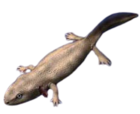
Walkerana phrynoderma is a species of frog endemic to the Anaimalai Hills, of the Western Ghats of Kerala and Tamil nadu states in southern India. This species is known from Munnar, Eravikulam National Park, Valparai tea gardens, Anamalai Tiger Reserve, Grass Hills National Park and Palni hills. It is a very rare terrestrial frog species associated with leaf-litter in tropical moist forest. It is threatened by habitat loss caused by subsistence wood collecting. It has the status of one of the "Top 100 Evolutionarily Distinct and Globally Endangered Amphibians".

Ambystoma rivulare is a species of mole salamander in the family Ambystomatidae. Typically gains a lot of population distribution in the Trans-Mexican Volcanic Belt around central Mexico City. Found in various small or medium-sized ponds and lakes that have large and wide range of food options, all within a distance of at least 2 km. It is endemic to Mexico. Its natural habitats are subtropical or tropical moist montane forests and rivers. It is threatened by habitat loss. The larvae, who continue to prey on the same organisms as they grow, prey mainly on ostracods as well as some gastropods and assorted other prey with limited diversity. Ambystoma rivulare continue to live in the river they hatch in post-metamorphosis. Research on the Michoacan Stream Salamander has important implications for the conservation and persistence of these salamanders. The lack of variety in the A. rivulare diet puts them in a precarious situation should environmental factors endanger the ostracod population in their habitat. Further, a study done at the University of Sao Paulo on the diet of A. rivulare shows no relationship between size and the salamander's diet, suggesting a lack of larger prey for the bigger salamanders to eat.

Chthonerpeton braestrupi is a species of caecilian in the family Typhlonectidae. It is endemic to Brazil. Its natural habitats are rivers, swamps, freshwater marshes, intermittent freshwater marshes, pastureland, irrigated land, seasonally flooded agricultural land, canals and ditches.
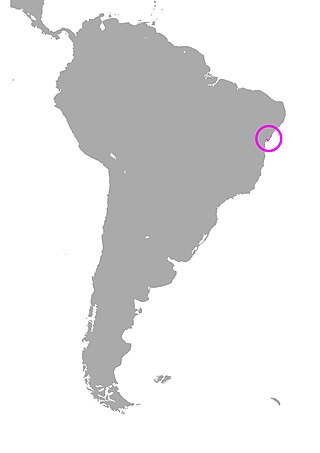
Chthonerpeton noctinectes is a species of caecilian in the family Typhlonectidae, endemic to Brazil. Its natural habitats are subtropical or tropical seasonally wet or flooded lowland grassland, swamps, freshwater lakes, and pastureland.
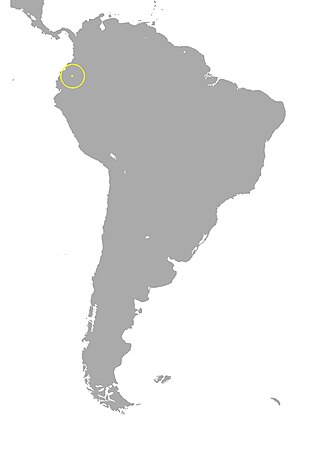
Chthonerpeton onorei is a species of amphibian in the family Typhlonectidae, endemic to Ecuador. Its natural habitats are subtropical or tropical moist montane forests, rivers, swamps, freshwater marshes, intermittent freshwater marshes, pastureland, irrigated land, seasonally flooded agricultural land, and canals and ditches.
Hyalinobatrachium orientale is a species of glass frog in the family Centrolenidae. It is found on the island of Tobago and in eastern Venezuela. Its common name is eastern glass frog. The Tobagonian population has been described as subspecies Hyalinobatrachium orientalis tobagoensis(Hardy, 1984). The latter is sometimes referred to as Tobago glass frog. H. orientale is distributed throughout the Central Eastern ranges of the Cordillera de la Costa in Venezuela and Tobago Island with an altitudinal range of 190 to 1200 meters.
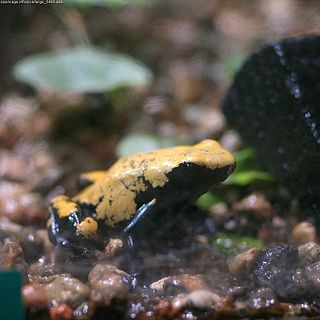
Adelphobates galactonotus is a species of poison dart frog. It is endemic to the rainforest of the southern Amazon Basin in Brazil. Its natural habitats are tropical moist lowland forests. The eggs are laid on the ground, but the tadpoles are carried to temporary pools. Though it remains widespread and locally common, it is threatened by habitat loss and has already disappeared from some localities due to deforestation and flooding caused by dams. The species is relatively common in captivity and regularly bred, but the wild populations are still at risk from illegal collection.

Dendropsophus branneri is a small hylid tree frog endemic to the Atlantic Forest region of Brazil. It feeds mainly on arthropods and is preyed upon by various invertebrates and vertebrates. Although currently classified by the IUCN Redlist as "least concern", D. branneri suffers rapid habitat loss due to residential development, agriculture, logging, and clearing for pastureland. Male D. branneri are noted for their fighting call, which differs significantly in frequency, duration, and pulses per call compared to their mate advertisement call. Males are also noted for their willingness to escalate physical altercations against other males, which includes kicking, pushing, and wrestling their opponent into non-dominant positions. Unlike most other frog species, D. branneri can breed in both temporary and permanent pools allowing it to inhabit a wide variety of habitats leading to its wide distribution.
Warren's tree frog is a species of frog in the family Hylidae found in Guyana and possibly Brazil and Venezuela. Its natural habitats are subtropical or tropical moist montane forests, rivers, freshwater marshes, and intermittent freshwater marshes.
The Lema tree frog is a species of frog in the family Hylidae found in Guyana, Venezuela, and possibly Brazil. Its natural habitats are subtropical or tropical moist lowland forests, subtropical or tropical moist montane forests, rivers, pastureland, rural gardens, heavily degraded former forests, aquaculture ponds, and canals and ditches. It is threatened by habitat loss.
Hoogmoed's tree frog is a species of frog in the family Hylidae found in Guyana, possibly Brazil, and possibly Venezuela. Its natural habitats are subtropical or tropical moist montane forests and rivers.
Nesorohyla is a monotypic genus of frogs in the family Hylidae. The sole species is Nesorohyla kanaima, also known as the Kanaima treefrog. It is endemic to Guyana. and possibly Brazil and Venezuela. Its natural habitats are subtropical or tropical moist lowland forests, subtropical or tropical moist montane forests, and rivers.
Pseudis tocantins is a species of aquatic frog in the family Hylidae. It is endemic to central Brazil and occurs in the eponymous state of Tocantins, as well as in Goiás, Mato Grosso, and Maranhão states, in the Tocantins and Araguaia River basins.
The Caatinga horned frog is a species of frog in the family Ceratophryidae. It is endemic to Brazil. Its natural habitats are dry savanna, subtropical or tropical dry shrubland, subtropical or tropical dry lowland grassland, and intermittent freshwater marshes. They are voracious predators that use a sit-and-wait feeding strategy to ambush prey, which includes ants and small vertebrates. They are also known to be explosive breeders.
Hylodes dactylocinus is a species of frog in the family Hylodidae. It is endemic to Serra do Itatins, in the São Paulo state, southeastern Brazil.
Stefania ayangannae is a species of frog in the family Hemiphractidae. It is endemic to Guyana where it is known from Mount Ayanganna and Mount Wokomung, both in the Pacaraima Mountains.
Stefania roraimae is a species of frog in the family Hemiphractidae. It is endemic to Guyana. Its type locality is Mount Roraima; it is also known from Mount Ayanganna and Mount Wokomung. It presumably occurs in the adjacent Venezuela and Brazil too.

Stereocyclops histrio is a species of frog in the family Microhylidae. It is endemic to the northeastern Bahia state of Brazil where it occurs in remnants of the Atlantic forest. After the holotype was collected in 1944, the species went unrecorded until a population was found in the Una Biological Reserve and its surroundings in 1999. It is now known from four locations. Common name Bahia yellow frog has been coined for it, perhaps in reference to the bright lemon yellow coloration of the holotype. It was the only species in the genus Hyophryne until 2012 when molecular data demonstrated that it is nested within Stereocyclops species.
Pandanus petersii is a species of plant in the family Pandanaceae. It is endemic to Mozambique; its habitat ranges from Namacurra to Quelimane and the Zambezi Delta. Typical features of its habitat are woodland remnants in swampy or wetland places. It is threatened by habitat loss.
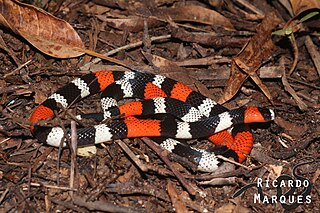
Micrurus ibiboboca, the caatinga coral snake, is a coral snake in the family Elapidae. It occurs in eastern Brazil, south of the Amazon.













